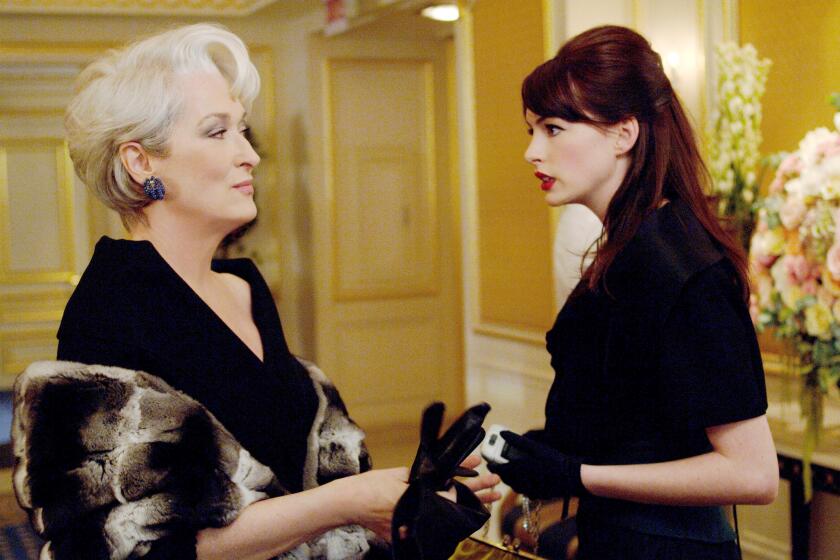Surveying Ed Moses, the Master of Surprise
- Share via
Asked to describe the appearance of Ed Moses’ art, one would be obliged to say, “It looks like the work of an Abstract Expressionist.” Asked which one, one would be obliged to reply, “All of them and none of them.”
The truth of that conundrum is fleshed out by the first full-scale survey of the artist’s career, which opened Sunday at the Museum of Contemporary Art. Titled “Ed Moses: A Retrospective of the Paintings and Drawings 1951-1996,” the show provides in 64 works a singular overview of an artist unique even among rarae aves.
As a piece of museum theater, the exhibition achieves that simple state of grace called Getting It Right. MOCA did right in choosing New Yorker John Yau as guest curator. Yau did right by writing an utterly exemplary catalog essay that is a model of conciseness, clarity and insight. Even the installation tells something about the Existential quirkiness of Moses’ path. It’s arranged in reverse chronological order.
Moses just turned 70. Generationally that places him closest to such now-departed modern classical California abstract painters as John McLaughlin, Richard Diebenkorn and Sam Francis. Like them, Moses served in World War II. Yet he has always been counted among a generation at least a decade his junior, the hip young pioneers of the Ferus Gallery who put L.A. art on the international map back in the 1960s. Something about his temperament--Yau calls it restlessness--led Moses to the manifest desire to make art that acts as a mega-summarization of his epoch’s aesthetic preoccupations.
Moses is obsessed with avoiding predictability and does so with baffling success. This is significantly due to his use of offbeat materials and techniques. He’s employed everything from layered epoxy to carpenter’s chalk lines, mops and rubber squeegees to force himself to surprising results. All the same, it’s possible to sketch the principal concerns that fuel his art.
All artists think about other artists, but Moses is particularly keen on Modernist genealogy. His work suggests an attitude toward his peers that combines abject admiration with combative competition. Over the years he has virtually rethought Modernism, from Malevich’s absolutist control to Pollock’s Dionysian spontaneity. He grafted this legacy to the Beat Generation’s idealism and attraction to Zen (Moses is an ardent student of Buddhism), wove that into the L.A. Finish Fetish’s concern with materials and topped the whole thing off with aspects of optical phenomenology derived from the California Light and Space art he helped pioneer.
Miraculously, one never thinks about this potentially ruinous eclecticism while looking at any given work. Moses manages to dominate his sources by fusing them through acts of personal intensity.
*
The earliest pieces on view are the most predictably derivative. There are Venice nightscapes that combine the playfulness of Paul Klee with the psychotic quality of a local street artist named Ed Newell. Early abstractions are clearly learning from Arshile Gorky, Philip Guston and the hilariously scatological drawings of John Altoon. One of these, “Y Branco,” 1957, frames Moses’ full name in a kind of comic-strip balloon introducing thoughts of then-dawning Pop art.
By 1963 Moses achieved personal distinction in a series of large, compulsively detailed “Rose” drawings. Tipping their hat to the emblematic work of Billy Al Bengston, they bring in a quality of European refinement reminiscent of a French decadent like Vuillard but overlaid with something sinister.
Moses’ art really got legs in the early ‘70s. He became preoccupied with compositions of interlaced diagonal bands. Probably inspired by the reductive thinking of Frank Stella, the resulting works have an astonishing optical drama that’s all their own. Compositions like “NY-Trac II,” 1974-75, appear as layers of tilted grillwork racing into a vortex of deep space. They create a literal gut sensation like that breathtaking scene in “Star Wars” when the young hero flies his space-fighter through the enemy labyrinth guided only by the spiritual power of the Force.
As time passed, this controlled attack softened and melted into other thoughts. Ten years later Moses’ rigid grid had burned into shapes resembling charred tree trunks that are at the same moment liquid. Gradually, as in “Casso y Ries,” 1990, they come to suggest the shadows of monsters on cave walls. Two years later, responding to a visit to Lascaux, L.A. graffiti art and its riots, Moses made his first recognizably figurative art in decades. Called the “Ror Shock” paintings, they include images that, as Yau says, make Art Brut “look as tame as a llama in a petting zoo.”
“Ranken #2,” 1992, for example, appears at a glance to be a serene, philosophical classic Chinese landscape. One is abruptly disabused of this impression when the image melts into two grotesque profiles. Withered and of uncertain gender, they touch their extended tongues in undefined intercourse of raunchy implication.
Retrospectives are supposed to be revelatory, and in that way surprising. Much of what is here is reassuringly what Moses’ admirers already appreciate about him, such as the way he combines seemingly endless, childlike inventiveness with a kind of magisterial control of his means.
What takes one unawares is the consistency of temperament that emerges from the ensemble. All this work is about one thing--themes and variations expressing a certain kind of terror. The 18th century notion of the Sublime comes to mind with its implications of the awe-inspiring sensations of raw nature. Moses, however, has internalized and generalized all that so that his expression of anxiety sits right on the border between the subjective and the empirical.
Yet the art has never been static. It took us along, if you like, on a quest that began when Moses was the young hero, Luke Skywalker, and continues until now, when he has become the seasoned guru, Ben Obi-Wan Kenobi.
The present role is embodied in new paintings done especially for the occasion. The largest Moses has ever done, they are cosmic in character, suggesting black skies full of stars and planets. The central gesture in “A.P.M.” looks at once like an enlarged Barnett Newman zip, a section of the spine and a rocket blasting off to uncharted galaxies.
What all this adds up to is art that can hold its own and assert its distinction against any other art made at any time, any place, anywhere.
* Museum of Contemporary Art, 250 S. Grand Ave., through Aug. 11, closed Mondays, (213) 626-6222.
More to Read
The biggest entertainment stories
Get our big stories about Hollywood, film, television, music, arts, culture and more right in your inbox as soon as they publish.
You may occasionally receive promotional content from the Los Angeles Times.










